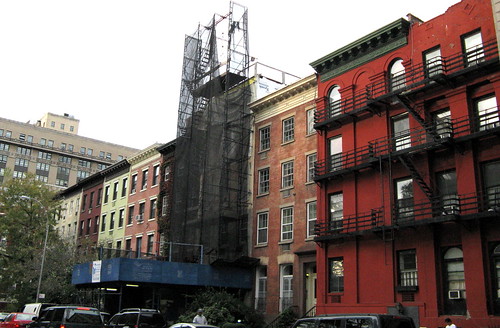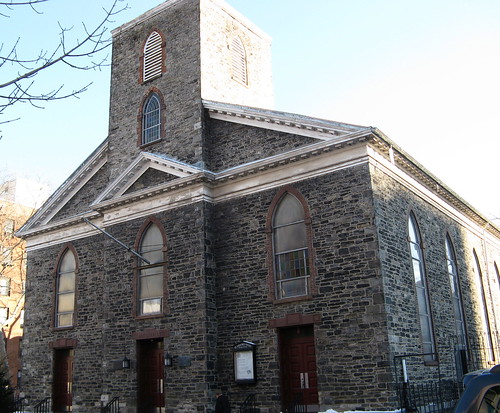In a win for those seeking to preserve the history of an abolitionist’s house where escaped slaves found safe passage, the New York City Landmarks Preservation Commission (LPC) decided early last week that the owner must abandon plans for a fifth-floor addition and restore the building to its original height. In a city of 8 million people and huge buildings going up, this may seem like a tiny bit of news. However, it’s an enormous triumph for preservation and the witnessing of Civil War history in New York City. It also shows again how citizen activism and a responsive government entity make a difference for future generations.
Led by two women, Fern Luskin and Julie Finch, the group – known as the Friends of the Hopper Gibbons Underground Railroad Site and Lamartine Place Historic District – campaigned persistently for keeping the building’s original roofline. They have worked hard for nearly 10 years, without giving in. They maintained all along that that the owner’s effort to construct a penthouse addition to the 19th century row house at 339 West 29th Street would destroy its historic integrity. The Hopper-Gibbons house, where Abigail Hopper Gibbons, her husband James Sloan Gibbons, and their family lived, holds a truly priceless piece of history of the years leading up to and during the Civil War.
The Hopper-Gibbons house is the only remaining documented Underground Railroad building in Manhattan. Moreover, the roofline that the LPC voted to protect was the site of a dramatic chapter of history from the Draft Riots that occurred in New York City during the Civil War. Committed Quakers, Abigail Hopper Gibbons and her husband, James, were abolitionists who not only opposed slavery but took great risks to shelter and aid runaway slaves escaping northward.
During the Draft Riots that ensnared New York City for four days, July 13-16, 1863, what began as a protest about Union Army proscription erupted into rioting, violence, and destruction. The crowds especially vented their rage at black residents – 11 black men were lynched during the riots – plus those who were active in seeking to end slavery. Because of the couple’s sympathies and activism, their family and home became the targets of the mob. A rampaging crowd ransacked the row house and set fire to parts of it.
A Harrowing Escape
This is where the roofline comes in. As the crowds attacked the Hopper-Gibbons dwelling, the family’s two daughters fled across the rooftop. They were helped to safety by Joseph Hodges Choate, a renowned lawyer and family friend, and a neighbor. From the time that the owner put metal scaffolding and started to build an addition in 2007, Luskin, a nearby neighbor, became quite distressed about what was happening. She researched the house’s history, documenting its significance.
That was just the beginning of a long battle, as it turned out. Since then, Luskin, Finch, and other activists kept up a campaign to restore the house’s height and protect the block. The dwelling is part of the Lamartine Place Historic District, a row of houses built in 1847. They are on the northern side of West 29th Street, between Eighth and Ninth Avenue. One can scarcely believe that this row of 19th century dwellings in this part of Midtown Manhattan has survived.

The Hopper-Gibbons House, in a 2010 photo showing the shrouding and construction atop its roof
Even though the owner started to alter the home before the historic district designation, his work encountered legal setbacks several times. Originally, when owner Tony Mamounas began the addition, those concerned about the house filed complaints, and the city halted work in May, 2009, because it didn’t conform to approved plans. Several months later, in October, 2009, the Landmarks Preservation panel designated the block as the Lamartine Place Historic District. In two rulings, courts found that the owner needed to get Landmarks Preservation Commission approval for the rooftop construction, according to Chelsea Now. Meantime, the advocacy group enlisted representatives at every level of government and city preservation groups to support their campaign.
Those urging that the house’s historical integrity be maintained were elated about the LPC’s decision on May 23, especially because their campaign was by no means assured of success. The city Department of Buildings (DOB) ordered that the owner must remove the addition within 60 days, or the owner will be billed if the city agency needs to have it done.
”Rather Overwhelming Odds”
“Unbelievable. Our attorneys said this was a case that will make the history books,” Luskin wrote in an e-mail to those following the case. In crediting e-mails and communications to the LPC and a petition with more than 500 signatures, she added, “So, our words and civic action actually worked in the face of rather overwhelming odds.”
Why does the preservation of a place like this matter? It’s because this block and house represent a rare, tangible remaining survivor of the Civil War era in New York City, as a setting of momentous events that the nation and city endured.
A place such as the Hopper-Gibbons house has power. When one looks at its rooftop, you can see the exact place where family members escaped the raging crowd and the fire that some had set with torches. One can picture this! It presents an opportunity to view the house as it looked and reflect on a historical event, when people were fiercely at odds over the slavery question. Tensions were fueled by the draft falling disproportionately on the working class.
Local groups have highlighted this history and hope to do more of it. Earlier this year, a local advocacy group included the Hopper-Gibbons house on a Black History Month tour of Chelsea. Early on during the efforts to protect the building, Bronx students participated in a teach-in at the house in 2009 to call attention to the need to preserve it.
Despite New York City’s ambitious Landmarks Preservation Law and knowledgeable, committed historic preservation and neighborhood groups, many places have been lost in the city’s continual construction and destruction. Certain sites remaining from earlier centuries are priceless, and often by their presence teach history in deeper ways. The physical integrity of the Hopper-Gibbons house is essential to its story.
It is like that of St. Augustine of Hippo Episcopal Church, at 290 Henry Street in Manhattan, in the sense that a surviving building feature provides visual evidence of a difficult chapter of history. The structure was consecrated in 1828 as All Saints Church and became a part of Trinity Church in 1949 as St. Augustine’s Chapel. When the parish opened it in the 1820s, the Lower East Side church structure contained two slave galleries – dark, unventilated, box-like rooms located behind the church’s balcony on the sides of the organ. There, slaves sat on separate crude wooden stepped seating during services, while the white slaveholders could sit in pews on the main floor. Even though the church was consecrated in 1828, a year after New York’s law emancipating slaves took effect, slaves from other states who attended church services had to sit separately in these dark chambers.
As this Episcopal News Service article details, following a major fund-raising effort with various groups, the church restored the galleries. It has had guided tours and public programs focusing on the galleries’ haunting history. St. Augustine was part of the New York Landmarks Conservancy’s Sacred Sites Open House in late May.
St. Augustine of Hippo Episcopal Church, formerly St. Augustine’s Chapel and originally All Saints Church, on Manhattan’s Lower East Side
Many people do not accord these places the importance they deserve. In plain language, it doesn’t matter to them, and this ignorance has a cost in the present day in a lack of understanding history. Thus, we need to recognize and be grateful to people such as Luskin, Finch, and their advocacy group for their unyielding determination and for devoting countless hours of time and painstaking work. The next generations will be able to see this place, much as it was in the 19th century.
It has been a hard campaign, one never certain in outcome and still precarious until the owner complies. Make no mistake about it, however. history has won an important victory.




No Comments so far ↓
There are no comments yet...Kick things off by filling out the form below.